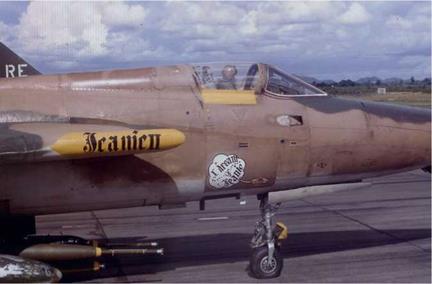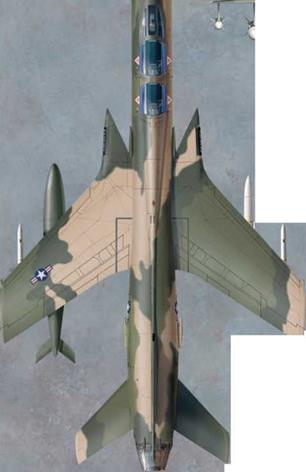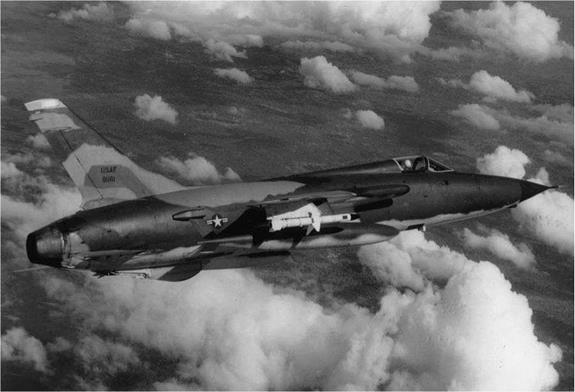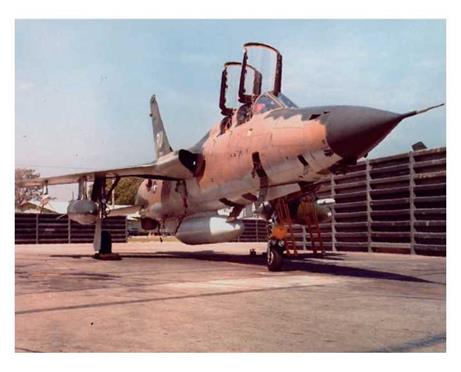DESIGN AND DEVELOPMENT
F-105F/G THUNDERCHIEF
For the first seven years of the F-105’s development and service, its pilots learned to fly the fighter in single-seat versions – the YF-105A, F-105B and F-105D. By 1963 the increasing complexity, weight and cost of these strike variants meant that it had become too hazardous to allow pilots to train wholly on single-seaters. USAF Air Training Command had requested a two-seat F-105B (designated the F-105C) in 1956, but this was cancelled in favor of the F-105E — a two-seat F-105D variant — the following year. The E-model was also cancelled in 1959 as a cost-cutting measure, but in June 1962 an order for 36 F-105Fs was approved, with another 107 planned for Fiscal Year 1963. The latter were financed by cancelling the last 143 F-105D-31-REs.
F-105Fs were intended to fly the same tactical nuclear strike missions as the F-105Ds. This role dated back to 1952 when Republic’s Chief Engineer, Alexander Kartveli, adapted his RF-84F Thunderstreak design to carry a small tactical nuclear weapon internally. Evolving slowly via YF-105A prototypes into the F-105B, the type eventually entered Tactical Air Command (TAC) service in 1959. Its massive J75 engine could drive it at 750 knots at ground-hugging altitude with a Mk 28 “nuke” aboard, or almost 1,200 knots at 36,000ft. The 45-degree swept wing spanned only 34.9ft (two feet less than a Spitfire from World War II) against a fuselage length of 63.1ft (similar to that of a C-47 Skytrain). With only 385 sq. ft of wing area to support 10 a 47,000lb take-off weight, the F-105B had limited maneuverability, but offered great
stability in its primary strike role. Evading enemy radar via terrain masking, it could outdistance any other fighter at low altitude.
The F-105D proposal in 1957 sought to give all-weather capability, particularly in the European Cold War scenario. A 15-inch fuselage extension allowed a 2,000lb increase in combat weight through the addition of an AN/ASG-19 fire control system,
FC-5 flight control system (FCS) and R-14A radar that was optimized for ground mapping. The jet’s limited all-weather capability came from the FCS, which permitted both visual and “blind” delivery of conventional and nuclear ordnance. The FCS’s terrain guidance mode also enabled the pilot to perform low-altitude navigation in poor visibility. In the cockpit, new vertical tape displays provided basic flight information at a glance. Externally, an arresting hook was added.
In an effort to offset the weight gain associated with these improvements, the aircraft was fitted with a Pratt & Whitney J75-P-19 engine whose water-injection gave it a short-term 2,000lb thrust increase for take-off at increased weight. The M61A1 20mm rotary cannon installed in the F-105B’s nose was moved back to accommodate the larger radar, the weapon drawing ammunition from a drum rather than via belts from a box as with the F-105B.
The first F-105D flew on June 9, 1959, and the 4th Tactical Fighter Wing (TFW), which was selected to introduce the aircraft into frontline service, was in business by late 1962. D-models eventually equipped 12 tactical fighter wings before going on to serve with Air Force Reserve and Air National Guard units until 1984.
In order to preserve the range and combat capability of the F-105D, Republic elected to extend its fuselage by 31 inches for the F-105F through the fitment of a “plug” ahead of the air intake line. The two cockpits were given separate canopies and the electronics compartments were moved behind the rear cockpit. The rear fuselage was strengthened and a new vertical stabilizer some five inches taller and 15 per cent larger in area was also added. These changes, together with beefier landing gear components, added 3,000lbs to the overall weight. Nevertheless, the F-105F could fly the same strike missions as the D-model jet, with the front-seat pilot performing most of the mission-related tasks.
Interest in the F-105F as an anti-SAM electronic countermeasures platform began in August 1965 after several US aircraft had been destroyed by SA-2s. However, the scarcity of F-105Fs meant that the more plentiful, though slower, two-seat F-100F was chosen to flight-test equipment for detecting and suppressing SAM sites. In record time, Applied Technologies, Incorporated (ATI) adapted existing ECM devices and produced the Vector IV RHAW set (based on its System 12 for the U-2), the IR-133 panoramic S-band receiver to locate emissions from the SA-2’s “Fan Song” guidance radar, and the WR-300 receiver that warned of the imminent launch of an SA-2.
Combat-tested in four F-100Fs, this equipment set, codenamed Wild Weasel I, enabled a flight of F-105Ds led by a Weasel Super Sabre to destroy a SAM site only five months after the first SA-2 shoot-down of a USAF fighter. However, the IR-133 was susceptible to jamming by USAF EB-66 aircraft operating in the same area and unable to home onto a “Fan Song” while the F-100F was maneuvering energetically. The
equipment did not indicate whether the aircraft was being tracked by a SAM either. 11
As part of their dominant role in the air war over North Vietnam, F-105D and F-105F Thunderchiefs attacked SA-2 sites as soon as permission was granted to do so. In this typical 1970 scene at Takhli RTAFB, Lt Col Jack Spillers, commanding the 355th TFW’s 357th TFS, begins a take-off roll in the relatively spacious single cockpit of F-105D 62-4229, named after his wife. Note that the Mk 83 1,000lb high explosive bombs attached to the jet’s center pylon have been fitted with fuze extenders. (Mrs J.
 Spillers via Norman Taylor)
Spillers via Norman Taylor)
 Republic Aviation had already tested an AN/APS-107 RHAW in an F-105D but rejected it in September 1965 in favor of the Vector IV as an urgent means of reducing the escalating attrition amongst Thunderchief units over North Vietnam. ATI and the Sacramento Air Material Area (SMAMA) successfully completed an installation in F-105D 62-4291 within five days, and a second aircraft was ready on 27 October 1965. This F-105D (61-0138) was fitted with a Bendix DPN-61 homing receiver, a fin-cap radar-warning receiver (RWR) and a SAM threat warning CRT display as the
Republic Aviation had already tested an AN/APS-107 RHAW in an F-105D but rejected it in September 1965 in favor of the Vector IV as an urgent means of reducing the escalating attrition amongst Thunderchief units over North Vietnam. ATI and the Sacramento Air Material Area (SMAMA) successfully completed an installation in F-105D 62-4291 within five days, and a second aircraft was ready on 27 October 1965. This F-105D (61-0138) was fitted with a Bendix DPN-61 homing receiver, a fin-cap radar-warning receiver (RWR) and a SAM threat warning CRT display as the
|
|

 |
 |
F-105G-1-RE 63-8336 PATIENCE of the 17th WWS/ 388th TFW in February 1973. This aircraft entered service as an F-105F with the 23 rd TFW in September 1964, and in March 1968 the jet went to war as a single-seat Combat Martin jammer aircraft with the 388th TFW at Korat RTAFB, although it actually flew most of its missions in a strike or Iron Hand role. Transferred to the 355th TFW in May 1969, 63-8336 then served with the 18th TFW at Kadena AB, prior to being flown back to the USA and placed in storage under 23 rd TFW management at McConnell AFB. Converted to F-105G configuration in 1972, the aircraft returned to the war torn skies of North Vietnam with the 17th WWS for Operation Linebacker I. The Thunderchief continued to fly Wild Weasel missions from Korat RTAFB until October 1974, when it was transferred to the 35th TFW and thence to ANG units and final storage at Davis-Monthan AFB in April 1982, with more than 4,000 flying hours on
first attempt to equip the jet for the SEAD role under project Wild Weasel II. This included F-105F 62-4421 using the AN/APS-107, the US Navy’s AN/ALQ-51 and external QRC-160-1 jamming pods.
The project was quickly replaced by Wild Weasel III, which focused solely on the F-105F with the AN/APR-25 (Vector IV), AN/APR-26 (WR-300, conceived by ATI’s Bill Doyle) and IR-133 — basically the Wild Weasel I suite. It was initiated on January 8, 1966 by Brig Gen Kenneth C. Dempster, who headed the USAF Anti-SAM Task Force from August 13, 1965. His brief from the outset had been to develop effective systems for tactical aircraft that allowed them to protect themselves from radar-directed weapons. A primary objective was the evolution and speedy deployment of fast hunter- killer teams to locate SA-2 sites using WildWeasel detection aircraft and destroy them with Iron HandF-105Ds equipped with 2.75-inch rockets, bombs and 20mm cannon. Republic and SMAMA had quickly modified the prototype F-105F (62-4416) to serve as the Wild Weasel III test-bed by February 3, 1966, and work began on six more F-105Fs while the prototype started a hasty test program at Eglin AFB.
The speed of the latter caused numerous quality control and technical problems with the installations, particularly the AN/APR-25, which failed to equal its performance in the F-100F because of inadequate co-axial cabling. With an imminent deployment to Korat RTAFB looming for five of the Thunderchiefs, all seven aircraft were re-worked and re-tested repeatedly, while six more F-105Fs were re-fitted in May 1966. An additional system was installed to help pilots locate SAM sites, particularly when they were well camouflaged. This ATL AE-100 system used a pattern of small antennas around the F-105F’s nose to receive azimuth and elevation information on an emitting “Fan Song” and display it so that a pilot could establish the direction of the threat radar. Delays in installing this gear, and in testing the rival AEL Pointer III system and the QRC-317 SEE-SAMS threat detection and evaluation system, meant that the five WildWeasel III-1 aircraft could not fly to Korat until May 28, 1966.
Although SEE-SAMS was initially rejected, development continued by North American Aviation and an improved SEE-SAMS B variant was evaluated in the Korat aircraft. In a period of experimentation with evolving ECM technology and tactics, together with the frequent development of relevant new products by the US defense industry, the WildWeasel F-105s received constant modification so that each aircraft soon had minor differences from the rest.
At Korat and Takhli RTAFBs the Weasels expanded the tactics pioneered by Wild Weasel IF-100F crews, although they initially continued to use the F-105F as a pathfinder/flight leader for three F-105D bombers on Iron Hand hunter-killer operations. With the adoption of the US Navy’s AGM-45 Shrike ARM from March 1966, however, the F-105F could now also make stand-off attacks on “Fan Song” radars rather than merely marking them with 2.75-inch rockets for F-105D bombers.
The employment of the Shrike also changed the role of Weasel crews during 1966-67, for missile-equipped F-105s could now suppress SAM batteries simply through their mere presence, forcing a “Fan Song” team to shut down rather than attract a radar-homing missile. It was no longer necessary to risk life and limb 14 physically knocking out an SA-2 site with bombs and/or rocket projectiles.

Another batch of 18 F-105Fs was pulled out of the training program from July 1966, these jets being fitted with ER-142 receivers operating in the E-G frequency bands in place of the IR-133 — the new receiver displayed its information on two panoramic cockpit scopes. The ER-142 was in turn superseded by the ER-168 (AN/APR-35), installed with the AN/ALT-34 jamming system. An improved SEE – SAMS set (eventually re-designated AN/ALR-31) boasting additional wing-tip antennas was installed in a number of F-105Fs in 1968.
Various built-in jamming systems, including the US Navy’s AN/ALQ-51 deception jammer, were tested to provide anti-SAM protection. All F-105s operating over North Vietnam were required to carry jamming protection, but pylon-mounted QRC-160- 1/8 pods used up a weapons station and could interfere with the Wild Weasel equipment. The solution to this problem came in the form of “split” AN/ALQ-101 pods, attached to either side of the lower central fuselage, housing QRC-288 (later QRC-335) jammer components. As the AN/ALQ-105, this system equipped the ultimate Thunderchief Wild Weasel, the F-105G.

![]() The jet’s most important enhancement was the provision of AGM-78A Mod 0 Standard ARM capability. This weapon — another US Navy initiative — had a warhead three times larger than the Shrike’s and a range three times greater than its 12-mile radius. The latter meant that aircraft could now fire an ARM from outside the effective range of an SA-2. And while the Shrike had to be launched almost directly at its target, the Standard ARM could be made to turn up to 180 degrees before homing on a
The jet’s most important enhancement was the provision of AGM-78A Mod 0 Standard ARM capability. This weapon — another US Navy initiative — had a warhead three times larger than the Shrike’s and a range three times greater than its 12-mile radius. The latter meant that aircraft could now fire an ARM from outside the effective range of an SA-2. And while the Shrike had to be launched almost directly at its target, the Standard ARM could be made to turn up to 180 degrees before homing on a
hostile radar. If that radar was turned off (which would cause a Shrike to break lock and fail), the AGM-78 used a memory circuit to log the last known position of the radar signal and continue to head towards it.
Fourteen F-105Fs were modified to carry the AGM-78 from September 1967, and eight of these entered combat fromTakhli in early March 1968. A year later the ECM suite was radically updated to handle the AGM-78A Mod 1 missile and, in due course, the AGM-78B. Retaining only the AN/ALT-34 jammer and AN/ALR-31 (SEE – SAMS), the new installation used an AN/APR-35 panoramic receiver and AN/APR-36/37 sensors in place of the AN/APR-25/26. New missile control panels, a tape recorder and a tracker to feed back information on the missile’s flight in order to estimate its likely success rate were also installed. Deliveries of revised “Mod 1” aircraft began in January 1969, and the jets’ success in combat persuaded the USAF to standardize all surviving F-105F Weasels as Mod 1 airframes, re-designating them F-105Gs. With the addition of 12 new conversions, this placed 61 F-105Gs in the active inventory. They all received the AN/ALQ-105 suite in due course too, although a few F-105Gs entered combat before these external fuselage pods were added.
In this guise the F-105 Wild Weasel fought through the final stages of the Vietnam War in 1971-73, out-performing its intended replacement, the F-4C Phantom II Wild Weasel TV. The latter lacked AGM-78 capability, and from 1966 onwards never reached the standard of electronics systems reliability achieved by the F-105G.











